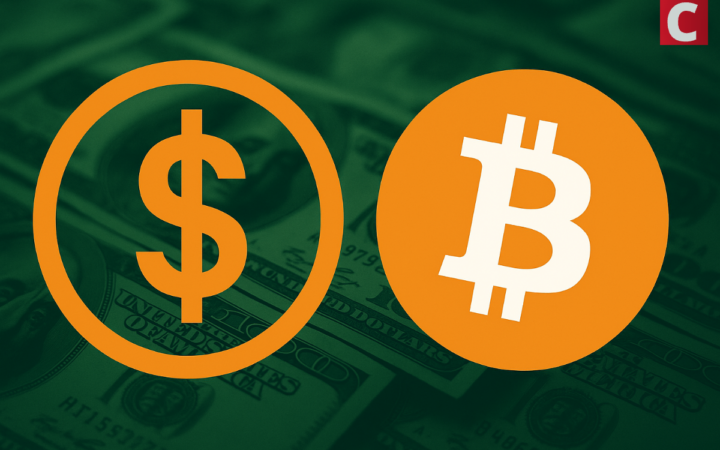
Please check out latest news, expert comments and industry insights from Coinspeaker's contributors.
Cryptocurrency values result from the confluence of factors like interest rate differences, supply-demand mechanics, investor sentiment, and confidence.
 Edited by Julia Sakovich
Updated
7 mins read
Edited by Julia Sakovich
Updated
7 mins read

The cryptocurrencies value is determined by several key factors, most notably supply and demand dynamics, investor sentiment, and confidence in the market. Since cryptocurrencies are not backed by governments or physical assets like traditional currencies, their valuation stems from utility, scarcity, and perceived value.
The relationship between supply and demand plays a major role in cryptocurrency prices. When demand for a specific cryptocurrency is high but supply is limited, its value tends to increase. On the flip side, prices may fall if demand declines or if more tokens enter circulation.
Market sentiment also sways cryptocurrency values. Optimistic news like regulatory progress, institutional adoption, or technological innovations can buoy prices. Conversely, discouraging developments such as security problems, stricter regulations, or public wariness may dampen enthusiasm and cause values to drop.
Furthermore, the general confidence of investors and macroeconomic conditions influence cryptocurrency prices. Factors like market speculation, trading volumes, liquidity events, and broader economic indicators can greatly impact investor outlook and, subsequently, crypto valuations.
Cryptocurrencies trading entails buying and selling digital or virtual tokens that employ cryptography to ensure security. Cryptocurrencies are decentralized, commonly leveraging blockchain technology, a distributed ledger that verifies and records all transactions on a peer-to-peer network. Bitcoin stands out as one of the largest and most well-known cryptocurrencies, along with other major tokens like Ethereum, XRP, and Litecoin
Cryptocurrencies enable the transfer of value without requiring third-party intermediaries such as banks. Their potential for decentralization, privacy, and introducing novel financial use cases fuels their expanding popularity.
While both are mediums of exchange, cryptocurrencies and fiat currencies differ considerably.
Fiat currencies, such as the US Dollar or Euro, derive authority from governmental decrees and central bank policies. Cryptocurrencies operate on decentralized blockchain networks, free from centralized control or oversight.
Physical fiat currency exists in tangible form like paper bills and metal coins for in-person payments. As purely digital assets, cryptocurrencies reside in digital wallets and transmit across their networks for settlement.
Central banks oversee the fiat money supply, wielding power to implement monetary policies that impact inflation and economic growth by printing or destroying money. The minting of popular cryptocurrencies like Bitcoin involves mining, where participants verify transactions to earn tokens as rewards. Most cryptocurrencies have an immutable total stock dictated by underlying protocols.
Cryptocurrencies enable pseudonymous transactions that can be viewed on public blockchains but don’t explicitly name the parties involved. Fiat payments are typically more transparent, with banks documenting identities tied to accounts and overseen by regulators.
The values of cryptocurrencies are notoriously volatile, frequently experiencing extreme price fluctuations over brief timeframes. The comparative stability of fiat currencies relates more closely to prevailing interest rates, inflation, and macroeconomic conditions.
The dominant top fiat currencies differ across jurisdictions but generally include the US Dollar (USD), Euro (EUR), Japanese Yen (JPY), and South Korean Won (KRW). Their global status and widespread availability as trading pairs on leading exchanges cement their popularity.
However, the preeminence of any fiat currency for crypto trading depends on emerging regions and shifting preferences. While most traders first exchange fiat for crypto, those paid directly in cryptocurrency can circumvent this step.
Changes to the value and stability can reverberate throughout cryptocurrency markets. As alternative stores of value and hedges against fiat currency devaluation, prevalent cryptocurrencies like Bitcoin and Ethereum react to the dollar’s fortunes.
When the dollar weakens significantly, cryptocurrencies often become more attractive to investors seeking to limit exposure to continuing depreciation. The resulting uptick in crypto demand stemming from dollar instability can lead to appreciating prices across many major cryptocurrencies.
Moreover, cryptocurrency adoption and prices relate to government stances on fiat currencies. Countries with supportive crypto regulations tend to presage growing investment in digital currencies. However, restrictive policies and outright bans in specific areas dampen interest and negatively impact values.
Bitcoin’s recent rally has unfolded against the backdrop of the declining US dollar, as measured by the dollar index retracting from its heights. Bitcoin has correspondingly appreciated, partly fueled by the dollar losing some appeal now that US interest rates seem to have peaked. Cresting rates can influence yield spreads and the relative attractiveness of the dollar.
Interest rate differentials set by the central banks of different countries, interest rate differentials importantly signify the divergence between the expected returns on investments denominated in various currencies. Expressed as a percentage or basis points, interest rate differentials affect currency valuations, cross-border capital flows, and the appeal of foreign financial assets. Savvy global investors closely track interest rate differentials because of their impact on forex rates and international investment prospects.
For example, a country offering higher interest rates tends to attract foreign capital seeking better yields, lifting demand for its currency and thus its relative worth against currencies from countries with lower rates.
Central bank policies, inflation expectations, economic expansion, and other macroeconomic factors drive interest rate differentials between nations. As central banks adjust rates to control inflation, spur growth, or pursue other goals, the resulting interest rate gaps help shape currency prices and capital movements.
The interest rate differential between two currencies directly affects their exchange rate as a currency pair. Widening interest rate spreads lead to substantial currency pair movements by redirecting the flow of foreign capital.
Countries with higher interest rates tend to lure international investor capital with expectations of superior returns compared to other destinations. This influx of investment spurs demand for the higher-yielding currency, causing its value to rise relative to the currency of lower-rate jurisdictions.
Conversely, reduced investor enthusiasm for the currencies of countries with lower rates depresses their worth. Beyond influencing currency valuations, interest rate gaps also impact other economic levers like inflation, trade balances, and cross-border money flows. Central banks frequently adjust interest rates to finesse domestic conditions, indirectly causing interest rate divergences.
As a speculative asset class, cryptocurrencies exhibit heightened sensitivity to market sentiment – the prevailing investor psychology toward crypto assets or specific coins. Optimism generally spurs buying interest and fuels rising valuations. Pessimism conversely dampens enthusiasm and begets falling prices.
Sentiment and cryptocurrency markets share a reflexive relationship. Social media platforms, news items, and opinion leaders shape sentiment. Still, positive coverage and statements from influential voices equally drive sentiment. Adverse news events or regulatory threats generate negative sentiment that manifests in selling pressures.
Sometimes not grounded in material conditions, swings in market sentiment can cascade into volatility. Thus investors monitor sentiment gauges and analytical models to inform trading strategies. While powerful over short timeframes, sentiment alone provides an incomplete and sometimes misleading perspective.
Careful analysis of technology, adoption metrics, governance policies, and economic trends allows for more judicious positions.
In summary, market sentiment significantly sways cryptocurrency prices but should complement a holistic assessment of fundamental market conditions for thoughtful investment decisions.
In essence, cryptocurrency values result from the confluence of factors like interest rate differences, supply-demand mechanics, investor sentiment, and confidence. The recent appreciation in cryptocurrencies like Bitcoin aligns with the dollar weakening and slumping bond yields, making them attractive alternatives for value storage. News events and social media chatter establish market sentiment that directly impacts valuations across crypto markets. While powerful, sentiment represents one facet of crypto assessment and should confirm rather than lead analysis.
Disclaimer: Coinspeaker is committed to providing unbiased and transparent reporting. This article aims to deliver accurate and timely information but should not be taken as financial or investment advice. Since market conditions can change rapidly, we encourage you to verify information on your own and consult with a professional before making any decisions based on this content.

Please check out latest news, expert comments and industry insights from Coinspeaker's contributors.





